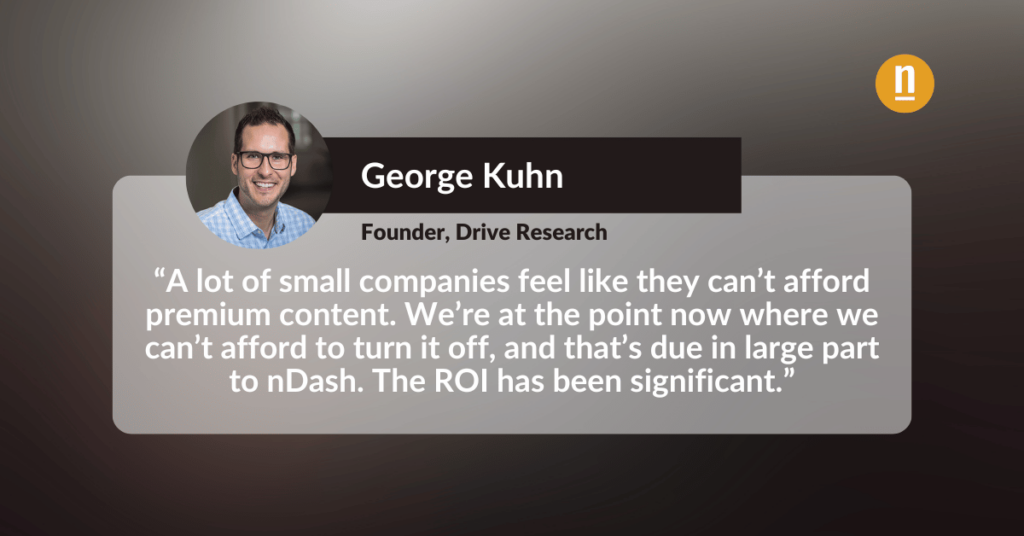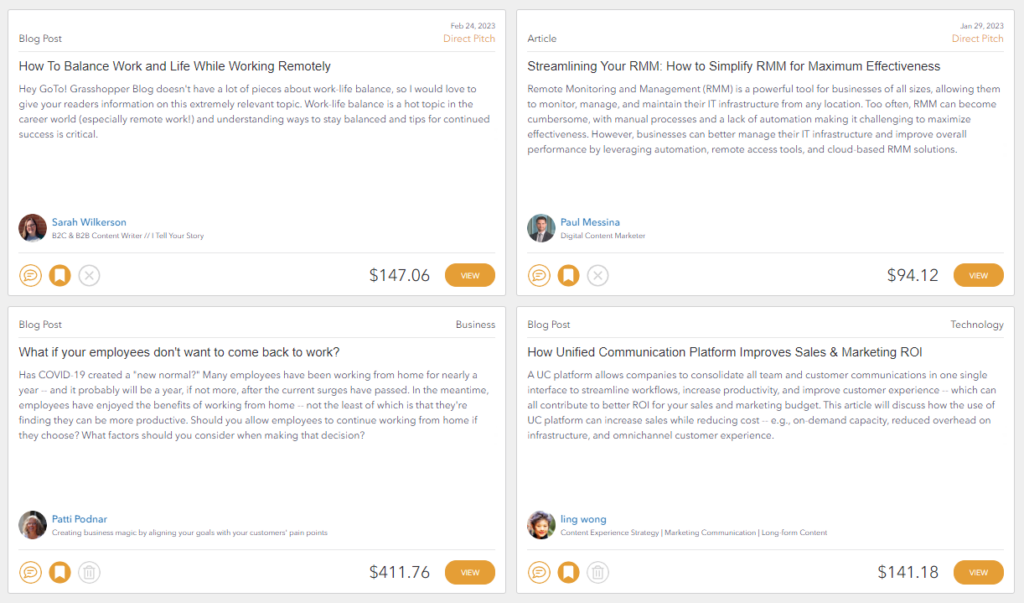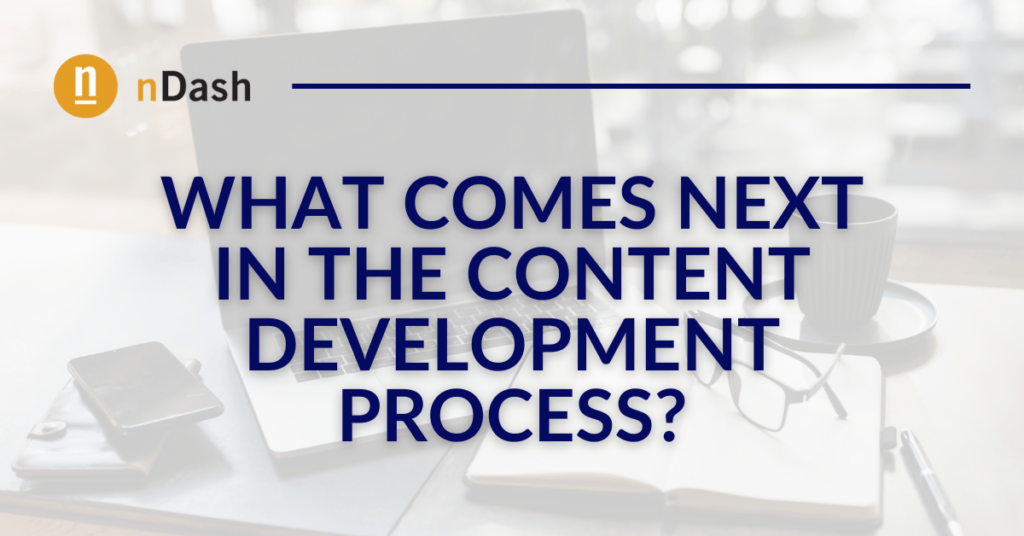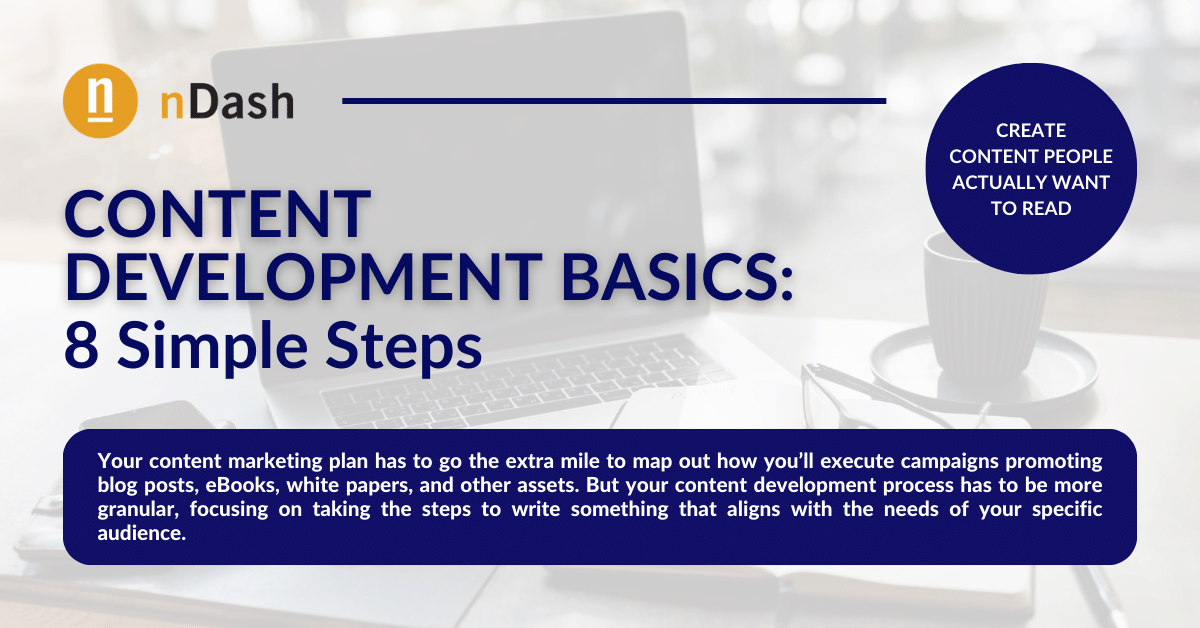Discover the eight simple steps to creating high-quality content that drives results throughout the content development process.
Navigating the Content Development Process
The returns on a content development process usually go either one of two ways.
You could spend months investing in content marketing only to find that the traffic needle hasn’t budged and leads aren’t pouring in the way you hoped. Or, you can see incremental successes that build over time and prove that those content investments were worth it.
What makes the difference?
No, it’s not just about funneling more money into paid advertising. That can help—but only if you’ve created something worth reading in the first place.
That’s why having the right content development process, strategy, and premium content is so important from the start.

What is Content Development?
Content development is the entire process of creating content to achieve specific business goals, including idea generation, topic research, keyword research, writing, and publishing—not just for a single piece of content but for a long-term strategy.
This process aligns more with the process of developing a content strategy. That process becomes a foundational pillar serving the wider content marketing strategy.
Your content marketing plan has to go the extra mile to map out how you’ll execute campaigns promoting blog posts, eBooks, white papers, and other assets.
But your content development process has to be more granular, focusing on taking the steps to write something that aligns with the needs of your specific audience.
Taking a more thoughtful approach to content development will keep you from publishing new pieces just for the sake of updating the website—and will get people to read your blog, download your white papers, and become qualified leads.
8 Simple Steps for Effective Content Development
If there were a one-size-fits-all approach to content development, everyone would follow it. But the reality is there’s a lot of nuance to the process. Seemingly small decisions could make or break your success. So you can’t just have a spray-and-pray method hoping that publishing anything that comes to mind will drive results.
Everyone’s content development process will look a bit different. Still, these eight simple steps will ensure you’ve covered all the bases necessary for a strategy that positively impacts your business.

Step 1: Set Content Development Goals
Whether you’re looking for advice about content marketing, content strategy, content development, or anything in between, you’ll probably notice that this is always the first step.
And it makes sense. New research that confirms a lack of documented content marketing strategies across B2B companies is published annually. For example, such research states that only 40% of marketers have a documented content strategy.
Without a concrete goal to strive for, your content development process will likely churn out content for content’s sake.
Think about the business goals you want to serve with your content. It could be any number of things, including:
- Building trust with your target audience.
- Generating qualified leads for your sales team.
- Sparking deeper loyalty with current customers.
- Improving the customer experience.
- Educating prospects and customers about your products.
- Overcoming your competitors on high-value SERPs.
Resist the urge to shout, “All of the above!” While all these goals sound great, trying to boil the ocean can become a recipe for disaster.
Being clear and concise about your goals will lead to better content development over the long term—which will actually help you drive other business goals initiatives of your original content goals.

Step 2: Identify Your Target Audience
What good is a content development process if you don’t know who it’s targeting?
The more specific you can get about your target audience, the better your content development process will be. Too often, content strategies take a broad strokes approach to an audience because businesses want to ensure they capture as many potential customers as possible.
But the truth is you can’t target an audience that matches your customer base. For the most part, your customer list will contain a wide range of companies—some you always knew would be good fits for your products and others you may never have considered.
When you make your content more specific, you allow yourself to become a highly trusted resource for a valuable segment of current or potential customers.
After identifying who your target audience is, ask yourself questions like:
- How does the target audience discover our content?
- What’s the most important factor for this audience when moving from awareness to consideration?
- Are there any types of content that perform better than others with this audience?
- Which other brands publish content that our target audience resonates with?
If your company has already developed granular buyer personas, that may be a good place to start learning about your target audience. But if you’re starting from scratch, doing everything you can to understand your ideal readers will make a major difference in the effectiveness of content development.

Step 3: Determine What Makes You Different
You already know you’re facing an uphill battle with content development.
There’s so much content already available tailored specifically to your target audience. And every second of every day, other brands and individuals add more content to the noise.
So, what do brands do in response?
They hunt for the latest and greatest best practices to ensure they publish content that gets results. Except you spend all that time checking off the best practices boxes only to find one thing—you still aren’t seeing the results you wanted.
While some general best practices can help (“write engaging headlines,” “don’t write giant blocks of text,” and “publish consistently”), most of them push you to develop content that looks like everyone else’s.
If you want your content to stand out over the long term, you must understand what makes you different. Everyone will strive to be as useful, educational, and inspiring as possible, but your specific brand voice and messaging will set you apart.
Consider how your brand’s approach to market can impact messaging for individual pieces of content and bigger content development processes. You don’t want your content to exist online in a no man’s land where you’re just reiterating recent news.
What should you do instead?
Have a specific viewpoint, take a stand, and develop content showcasing your company’s beliefs.
Documenting the specific difference markers makes it easier to remember this while writing specific assets.

Step 4: Choose Your Metrics for Content Development Success
Measuring the effectiveness of your content development process is critical to long-term success. Identifying which pieces of content generate results and which ones fall short will help you hone your craft and make iterative changes to the content development strategy.
But there’s a whole world of content marketing metrics available to you. Choosing where to focus your attention is critical, especially in the early days of implementing a content development process.
The highest level, most common metrics you can use to measure content development revolves around consumption. Everyone wants to drive more traffic to their business blog; great content development processes will help.
There’s more to content development than just traffic, though.
You can also track other metrics like:
- Social Shares: How many of your followers actively share individual pieces of content with a wider audience?
- Lead Generation: What’s the conversion rate for your content? For blog posts, are you driving readers to download a gated asset? For gated content, are people who opt-in then setting up calls with your sales team?
- SEO: How much organic traffic is your content driving per month? Has it changed since implementing a more formal strategy?
- Sales: Are readers becoming customers after consuming certain pieces of content?
Each category contains many different advanced metrics. Try to strike a balance between getting lost deep in the weeds of advanced metrics and putting too much stock in vanity metrics. Finding that middle ground will keep your content development process focused.

Step 5: Generate Content Ideas
The first three steps all lay the groundwork for you to create content that serves a valuable purpose consistently. Now, you have to start coming up with specific ideas.
Where do you even begin?

First, you must make a conscious effort to fill your creative well. Spend time consuming the content that your target audience cares about. Subscribe to the most prevalent newsletters, read industry blogs daily, and listen to relevant podcasts.
When you become a consumer of the content your target audience cares about, you’ll find that you can piece together more original ideas for your own content development process.
Idea generation doesn’t have to come down entirely to your own original thoughts, though.
There are other techniques you can take advantage of to fill out that editorial calendar:
SEO Competitor Analysis
Whether you have a full-blown SEO platform like Ahrefs or rely on a freemium tool like Ubersuggest, you can come up with plenty of content ideas by analyzing your competitors. Find which pages drive the most organic traffic for websites that serve your ideal customers. Then, find ways to make those content topics your own.
General Keyword Research
Beyond competitor analysis, you can use SEO tools to understand what your target audience cares about most. Understanding what they’re searching for, how often they’re searching, and how likely you are to rank for the keywords can help you make a prioritized list of content ideas.
Sales Team Collaboration
Your sales team spends all day talking to the people you want to develop content for. Make a point to talk to them regularly. Ask about common questions prospects have. Learn which product features they’re most interested in. Find out which selling points receive the most pushback. Turning these insights into content ideas will ensure you’re aligned with audience needs.
Enlist Freelance Content Writers
You can access a much wider range of content development experience when working with freelance writers. They’ll send you ideas of their own based on that experience, giving you a more diverse set of topics for content creation. Not only that, but expanding your content community will make life easier when it comes time to start writing.

Step 6: Write the Content
It says a lot when listing content development steps that the actual writing part doesn’t come until nearly the end.
Suppose you don’t do all the upfront work to craft a content development process that perfectly aligns marketing goals, business goals, and content ideas. In that case, it doesn’t matter how great you are at writing—you won’t see the best possible returns.
But now that you have the process in place—you know your goals, have a target audience, and have come up with great, relevant ideas—you can start writing.
Some guides would have you focus solely on long-form content. You may have seen graphics floating around that show blog posts with over 3,000 words generate the most backlinks and organic search traffic.
It’s true that in-depth, long-form content is more suited to receive backlinks and search traffic. Generally speaking, it’s more informative and covers a wider range of topics and keywords all at once.
That doesn’t mean every piece of content you write must be a massive how-to guide. Stay true to your goals and the needs of your target audience. More often than not, finding the right mix of long-form and short-form content is your best approach.
Whatever you do, make sure you’re always writing with humans in mind:
- Speak to the pain points of your target audience.
- Provide useful information that would be valuable, whether it was on your website or someone else’s.
- Don’t stuff keywords into every line, hoping to satisfy Google’s site crawlers.
- Avoid turning each piece of content into a sales pitch.
If you follow your content development process, you’ll be writing pieces that balance audience needs, search intent, and business goals. And that’s what will generate high-quality content.

Step 7: Optimize Content for Search
This might be more like Step 6.5, depending on how you prefer to work. However, it’s important enough to get its own category.
Ideally, you’ll have established a target keyword before writing a piece of content. But even if you haven’t, you can take the time to do some keyword research after the fact and optimize the post for search in the editing phase.
While many different SEO techniques and tactics contribute to high-ranking content, this content development stage requires you to optimize on-page SEO.
As you prepare to publish your content, run through a quick on-page SEO checklist to ensure you’re setting yourself up for success.
Ask yourself these questions before publishing:
- Is the keyword included in the post’s URL?
- Have you limited the length of your URL?
- Did you add the target keyword to your title tag?
- Does your content include long-tail modifications to the keyword?
- Do your header tags include the target keyword?
- Have you added alt text to images with the keyword?
- What external links have you included to boost authority?
- Which internal links can you include that are relevant to the topic?
None of these checklist items should take away from the fact that you’re writing for your audience, not the search engine. However, checking off these boxes will make your content more visible to Google so you can serve your audience while also increasing organic traffic.

Step 8: Hit Publish and Modify Content Development Plans
When you’ve finally finished writing and optimizing a piece of content, it’s time to send it out into the world.
But just because you hit publish doesn’t mean you can forget about the content and move on to the next piece. Content development is a long-term initiative, and it never ends.
After you finish step five and have a list of content ideas, use them to fill out an editorial calendar to keep track of a consistent publishing schedule. Then, you can develop individual content pieces to target audiences and customers.
Your editorial calendar is also a good place to determine which content you can repurpose later on. For example, if you have a high-performing blog post, you could:
- Turn it into a carousel on LinkedIn
- Expand it into a long-form piece of content
- Use it as inspiration for an infographic
- Extract quotes to use in social media imagery
- Create newsletter content from it
- Use it to create a podcast episode
As you monitor the successes, failures, and feedback from content development efforts, you can begin to modify your overall strategy. Making iterative changes will help you fuel your distribution strategy with high-quality content that consistently meet the audience’s needs.

What Comes Next in the Content Development Process?
The steps listed here don’t represent a silver bullet answer to your content marketing needs.
However, they should give you a framework for developing high-quality content that serves business initiatives. Once you have a stream of consistent, high-quality content, you’ll start to build trust with your target audience. And that’s what will unlock the value of content marketing.
Content has become the key element of effective marketing. Establish your content development process now and lay the groundwork for long-term success.
FAQs About Content Development
What does a content developer do?
Someone who is responsible for content development works on researching, strategizing, and preparing content. Then, they pass that information to in-house or freelance writing teams to write and edit articles, blogs, digital copy, and social media posts.
What skills are necessary for content development?
The skills necessary for content development include creative thinking, researching, writing, editing, search engine optimization (SEO), content management software proficiency, and content creation software.
What’s the difference between content development and content creation?
Those who are responsible for content development are the strategists – they lay the groundwork for what freelance writers do. They’re generating ideas, completing topic research, and completing keyword research. So, content development is done by a strategist, and an in-house or freelance writing team is responsible for content creation.
Editor’s note: This content was updated on 6/13/2023 to add graphics, expand information, and update stats.
